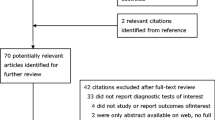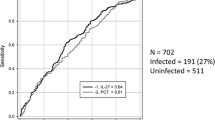Abstract
The aim of the present study was to determine whether the presence of an infectious focus or of fever alone can predict bloodstream infection and whether levels of C-reactive protein, procalcitonin, interleukin (IL)-6, IL-8, and soluble IL-2 receptor (sIL-2R) improve the diagnosis of community-acquired bloodstream infection. Markers of systemic inflammation were studied in 92 patients with community-acquired infection. On admission to hospital, 54 patients had an infectious focus, 25 had fever without an infectious focus, and 13 had neither. The presence of focus or fever predicted bloodstream infection (n=13 patients) with a sensitivity of 100% (95% confidence interval, 75–100), a specificity of 16% (95%CI, 9–26), a negative predictive value of 100% (95%CI, 75–100), and a positive predictive value of 16% (95%CI, 9–26). Positive predictive values of C-reactive protein, procalcitonin, IL-6, IL-8, and sIL-2R, all measured on admission, were also low (33–44%). Eight febrile patients in whom an infectious focus was found during a 3-day follow-up period had higher on-admission IL-6 (P=0.005) and sIL-2R (P=0.046) levels than did 17 febrile patients without an infectious focus. In conclusion, markers of systemic inflammation do not improve the diagnosis of community-acquired bloodstream infection; however, they may aid in identifying patients with fever due to occult infection.

Similar content being viewed by others
References
Bryan CS (1989) Clinical implications of positive blood cultures. Clin Microbiol Rev 2:329–353
Bossink AW, Groeneveld AB, Koffeman GI, Becker A (2001) Prediction of shock in febrile medical patients with a clinical infection. Crit Care Med 29:25–31
Bone RC, Balk RA, Cerra FB et al (1992) Definitions for sepsis and organ failure and guidelines for the use of innovative therapies in sepsis. The ACCP/SCCM Consensus Conference Committee. American College of Chest Physicians/Society of Critical Care Medicine. Chest 101:1644–1655
Peduzzi P, Shatney C, Sheagren J, Sprung C (1992) Predictors of bacteremia and gram-negative bacteremia in patients with sepsis. The Veterans Affairs Systemic Sepsis Cooperative Study Group. Arch Intern Med 152:529–535
Jones GR, Lowes JA (1996) The systemic inflammatory response syndrome as a predictor of bacteraemia and outcome from sepsis. Q J Med 89:515–522
Ispahani P, Pearson NJ, Greenwood D (1987) An analysis of community and hospital-acquired bacteraemia in a large teaching hospital in the United Kingdom. Q J Med 63:427–440
Rayner BL, Willcox PA (1988) Community-acquired bacteraemia: a prospective survey of 239 cases. Q J Med 69:907–919
Valles J, Rello J, Ochagavia A, Garnacho J, Alcala MA (2003) Community-acquired bloodstream infection in critically ill adult patients: impact of shock and inappropriate antibiotic therapy on survival. Chest 123:1615–1624
Takala A, Jousela I, Olkkola KT et al (1999) Systemic inflammatory response syndrome without systemic inflammation in acutely ill patients admitted to hospital in a medical emergency. Clin Sci (Lond) 96:287–295
Castell JV, Gomez-Lechon MJ, David M, Hirano T, Kishimoto T, Heinrich PC (1988) Recombinant human interleukin-6 (IL-6/BSF-2/HSF) regulates the synthesis of acute phase proteins in human hepatocytes. FEBS Lett 232:347–350
Wigmore SJ, Fearon KC, Maingay JP, Lai PB, Ross JA (1997) Interleukin-8 can mediate acute-phase protein production by isolated human hepatocytes. Am J Physiol 273(4 Pt 1, Suppl):E720–E726
Rubin LA, Kurman CC, Fritz ME et al (1985) Soluble interleukin 2 receptors are released from activated human lymphoid cells in vitro. J Immunol 135:3172–3177
Assicot M, Gendrel D, Carsin H, Raymond J, Guilbaud J, Bohuon C (1993) High serum procalcitonin concentrations in patients with sepsis and infection. Lancet 341:515–518
Nijsten MW, Olinga P, The TH et al (2000) Procalcitonin behaves as a fast responding acute phase protein in vivo and in vitro. Crit Care Med 28:458–461
Meisner M (2002) Pathobiochemistry and clinical use of procalcitonin. Clin Chim Acta 323:17–29
Takala A, Jousela I, Jansson SE et al (1999) Markers of systemic inflammation predicting organ failure in community-acquired septic shock. Clin Sci (Lond) 97:529–538
Takala A, Nupponen I, Kylanpaa-Back ML, Repo H (2002) Markers of inflammation in sepsis. Ann Med 34:614–623
Preas HL II, Nylen ES, Snider RH et al (2001) Effects of anti-inflammatory agents on serum levels of calcitonin precursors during human experimental endotoxemia. J Infect Dis 184:373–376
Netea MG, van der Meer JW, van Deuren M, Jan Kullberg B (2003) Proinflammatory cytokines and sepsis syndrome: not enough, or too much of a good thing? Trends Immunol 24:254–258
Chirouze C, Schuhmacher H, Rabaud C et al (2002) Low serum procalcitonin level accurately predicts the absence of bacteremia in adult patients with acute fever. Clin Infect Dis 35:156–161
Gleckman R, Hibert D (1982) Afebrile bacteremia. A phenomenon in geriatric patients. J Am Med Assoc 248:1478–1481
Fontanarosa PB, Kaeberlein FJ, Gerson LW, Thomson RB (1992) Difficulty in predicting bacteremia in elderly emergency patients. Ann Emerg Med 21:842–848
Author information
Authors and Affiliations
Corresponding author
Rights and permissions
About this article
Cite this article
Aalto, H., Takala, A., Kautiainen, H. et al. Laboratory markers of systemic inflammation as predictors of bloodstream infection in acutely ill patients admitted to hospital in medical emergency. Eur J Clin Microbiol Infect Dis 23, 699–704 (2004). https://doi.org/10.1007/s10096-004-1191-8
Published:
Issue Date:
DOI: https://doi.org/10.1007/s10096-004-1191-8




